2021 Harley-Davidson Pan America
So, Harley-Davidson has made an adventure bike. And you know what? They’ve had a red hot go at doing it and it’s actually pretty damn good!
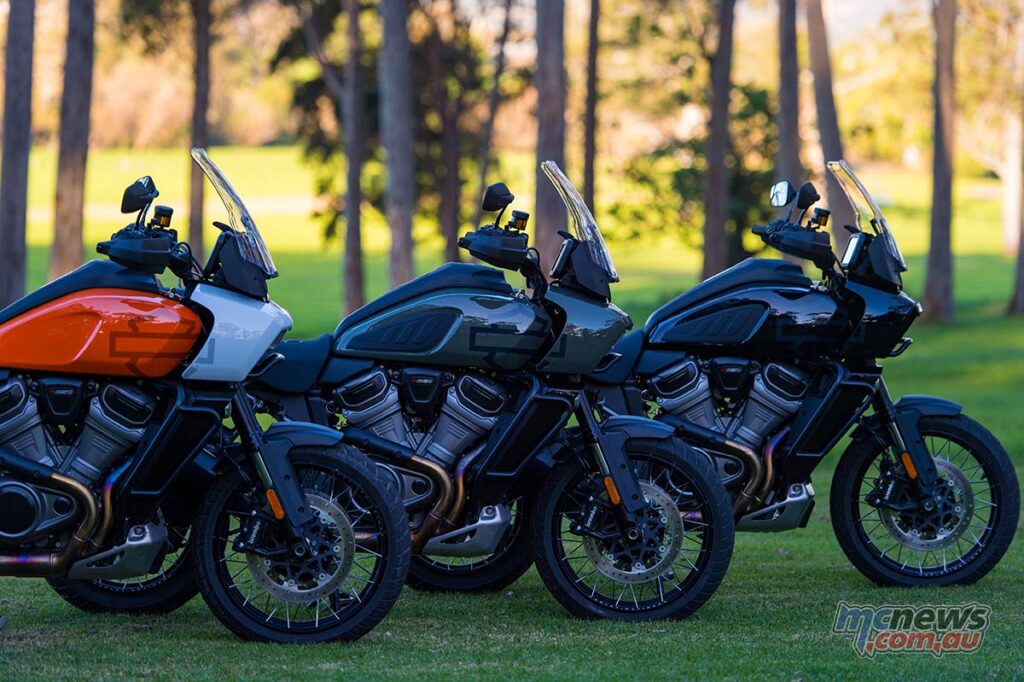
Milwaukee have evaluated the established peerage in the adventure-touring sector, examined what those bikes do well, where they could be improved upon, and then looked for points of difference they can bring to market in order to stand out from the crowd and make a statement.
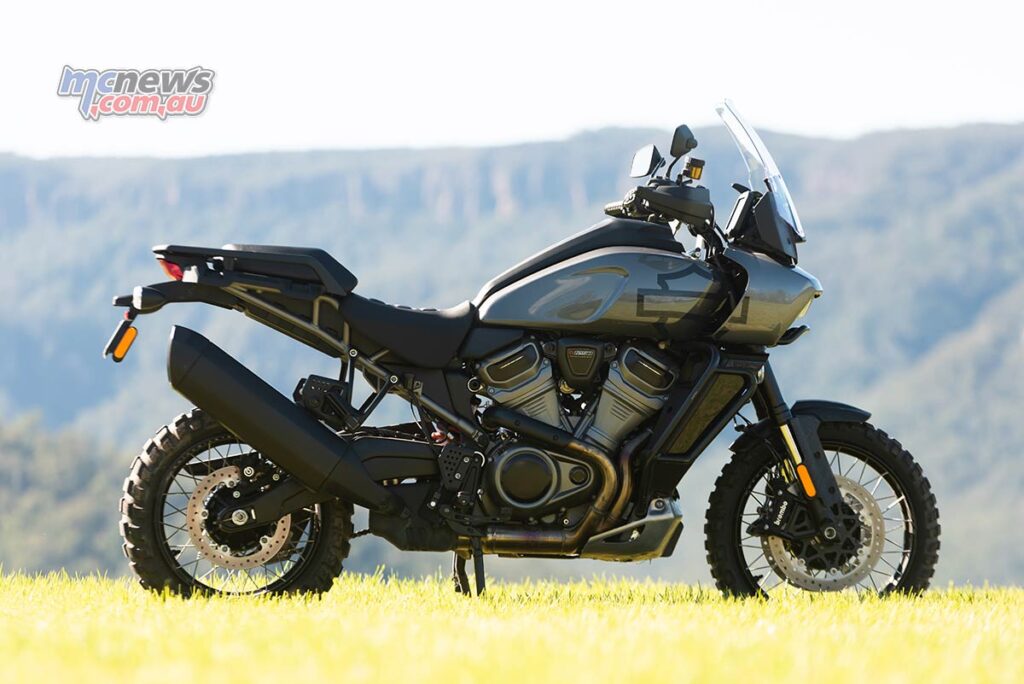
Tubeless spoked rims and adaptive ride height suspension will be optional extras that come together as a package priced at $1485.
And Pan America is quite a bold statement
At the recent Australian launch Harley-Davidson head honcho Nigel Keough started proceedings by declaring, “we compete to win and aim to make Pan America Australia’s #1 adventure-touring motorcycle and we believe it will be a game-changer’”
It wasn’t said with rodomontade, Nigel is fairly softly spoken, but the intent was clear nonetheless.
Looking at the list of features you can tell how well Harley have studied the competition in the sector, examined the ingredients that make for a successful recipe, then for the most part simply added those same components before blending and then putting it in the oven to bake.
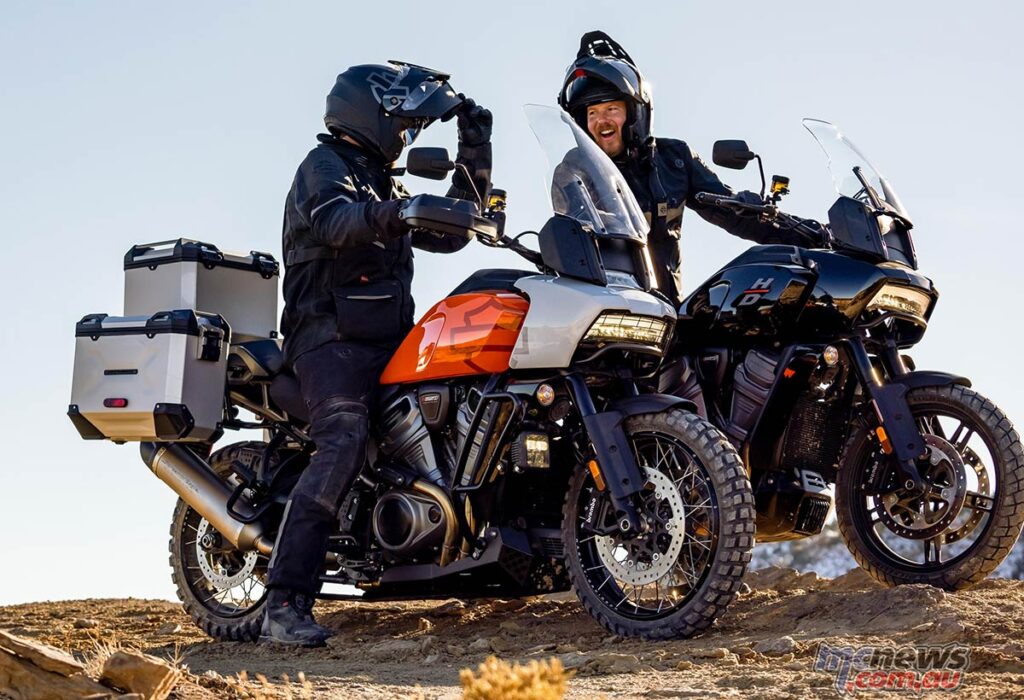
Adventure Tourer check-list
- 150 horsepower twin – check
- Radial Brembo stoppers – check
- Lean-angle sensitive ABS and traction control – check (Bosch)
- Electronic semi-active suspension – check (Showa)
- Cornering lights – check
- Tyre pressure monitoring – check
- Cruise control – check
- Heated grips – check
- 20+ litre fuel capacity – check
- 350km+ range – check
- Comfortable ergonomics – check
- Steering Damper – check
- Slip-assist clutch – check
- Hill Hold Control – check
- Engine Braking Control – check
- Ride Modes linked to corresponding different tunes for the suspension, ABS and traction control systems – check
- Adjustable seat height – check
- Adjustable screen – check
- Large TFT screen with mobile app driven navigation – check
- Powered USB ports at dash and under seat – check
- Luggage systems both hard/soft as accessories – check
That’s a pretty damn good start!
Harley have then added a couple of points of difference that will genuinely improve the experience for many.
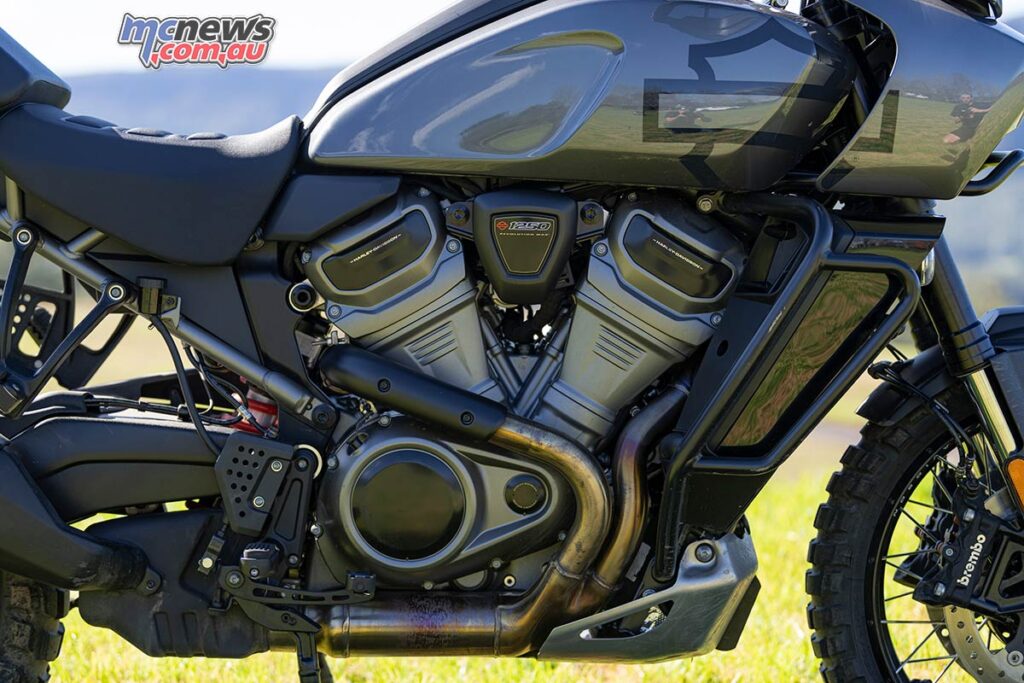
The all new Revolution Max engine utilises hydraulic lifters that activate tiny roller-rockers thus there are no valve clearance checks required. That $500+ saving every 32,000 km or so though is somewhat clawed back by the fact that Harley have set the minor service intervals at 8000 km, rather than the now industry norm of 16,000km. That said, if you go 16,000 km without doing an oil change yourself at least once during that period between dealership visits on any modern motorcycle, then I reckon you’ve got rocks in your head. Oil and filters are pretty damn cheap and if you plan on doing any serious adventure riding, then it also pays to get to know your motorcycle. Doing some basic maintenance yourself at home is a good way to gain such knowledge, rather than trying to work it out by the side of some dirt track on the side of a mountain 500 kilometres from home… Here endeth the Texas Tea sermon from Pastor Trev, back to the bike…
The real breakthrough, the one that will really make a point of difference that riders will appreciate every single time they mount or dismount the motorcycle, is the new automatic ride height and lowering system which is deployed for the first time in Pan America.
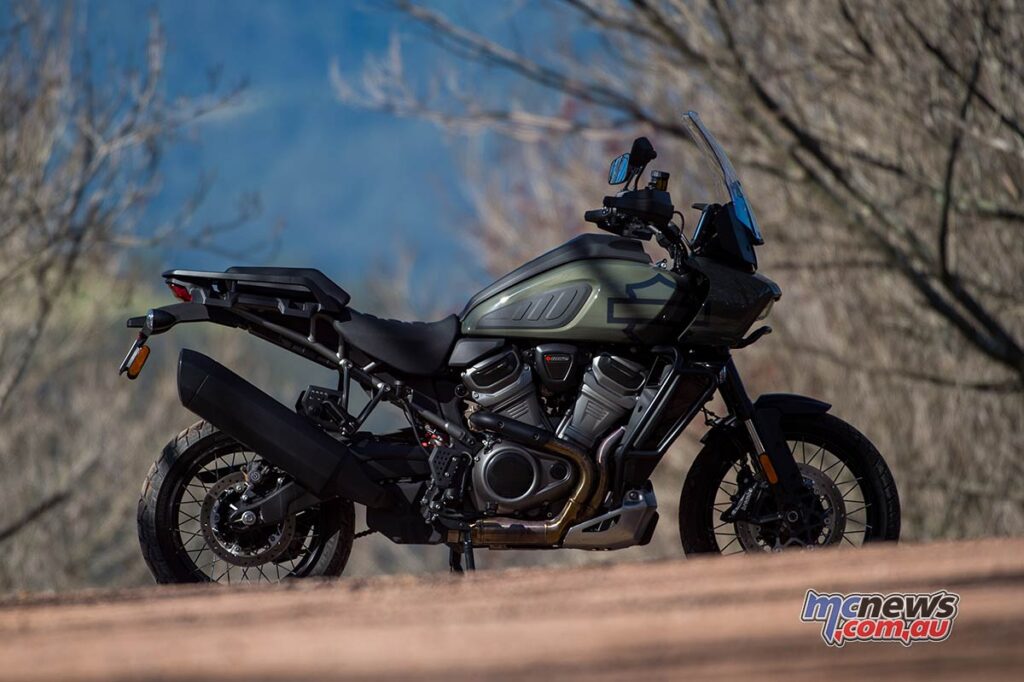
This is a true halle-fecken-lujah moment for the short of leg amongst us. This feature alone will capture the attention of many adventure-touring aspirants. When the machine comes to a stop it automatically sinks 25-50 mm closer to terra-firma, that figure depends on how much pre-load has been set on the suspension, and then raises up again as you move off from a standstill. It does it all automatically. Simply brilliant. Seriously, in such a competitive sector why has it taken until 2021 for this to come to market? Harley is kicking sand in the face of the established peerage good and proper with this feature, and good on them. Insert that Leonardo DiCaprio meme where he leans back and claps from The Wolf of Wall Street right here.
Inverted 47 mm Showa Balance Free forks control the 120/70-19 front while a BFRC shock helps ensure the power gets down to a 170/60-17 rear. The damping at both ends is semi-active and constantly adjusted on the fly to respond instantly to the corresponding road, load, throttle and braking demands being placed on the suspension.
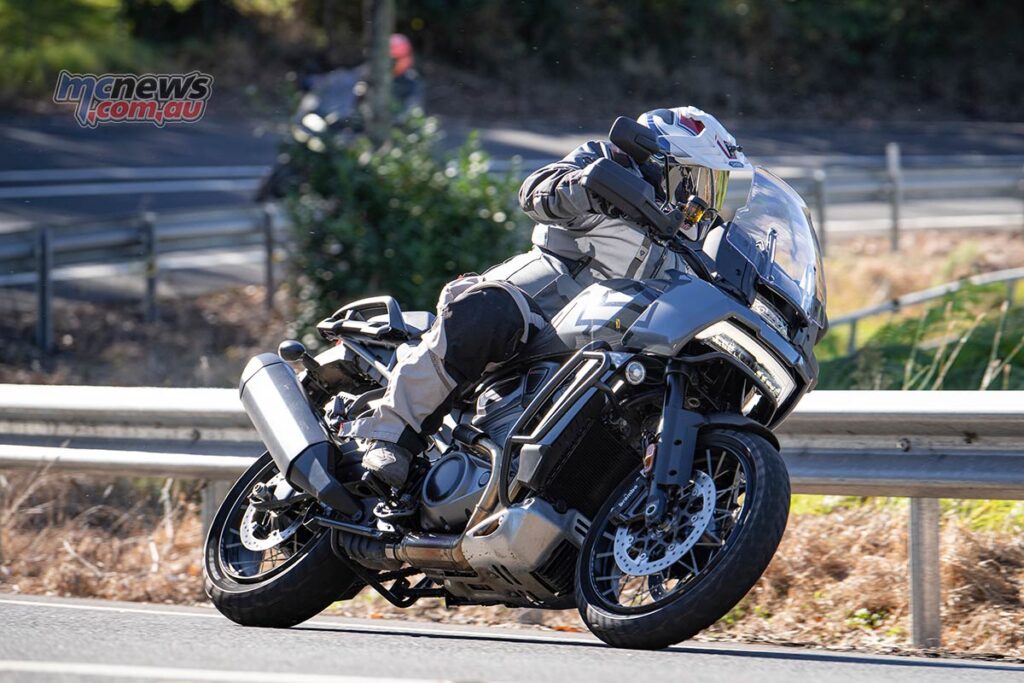
It’s somewhat akin to voodoo but it works, and like the electronic Showa used on Honda’s Africa Twin, it is generally a little more taut in its response than the WP, Sachs or Ohlins set-ups used by other competitors. Don’t translate that to mean harsh as nothing could be further than the truth, it’s just that all the Showa offerings I have sampled make the speed of damping changes rather more evident than many comparative systems.
Harley-Davidson developed the lowering and ride-height levelling software in conjunction with Showa, thus the technology will be only available on Harley motorcycles for the next year. Only then will Showa be allowed to offer the system to other manufacturers. This is a normal state of affairs when companies partner to develop, engineer, evaluate, test and map new technology through a shared investment. KTM did the same with Bosch when the 1190 Adventure was the first motorcycle to hit the road with lean-angle sensitive ABS back in 2014, which then filtered out to other brands in 2015.
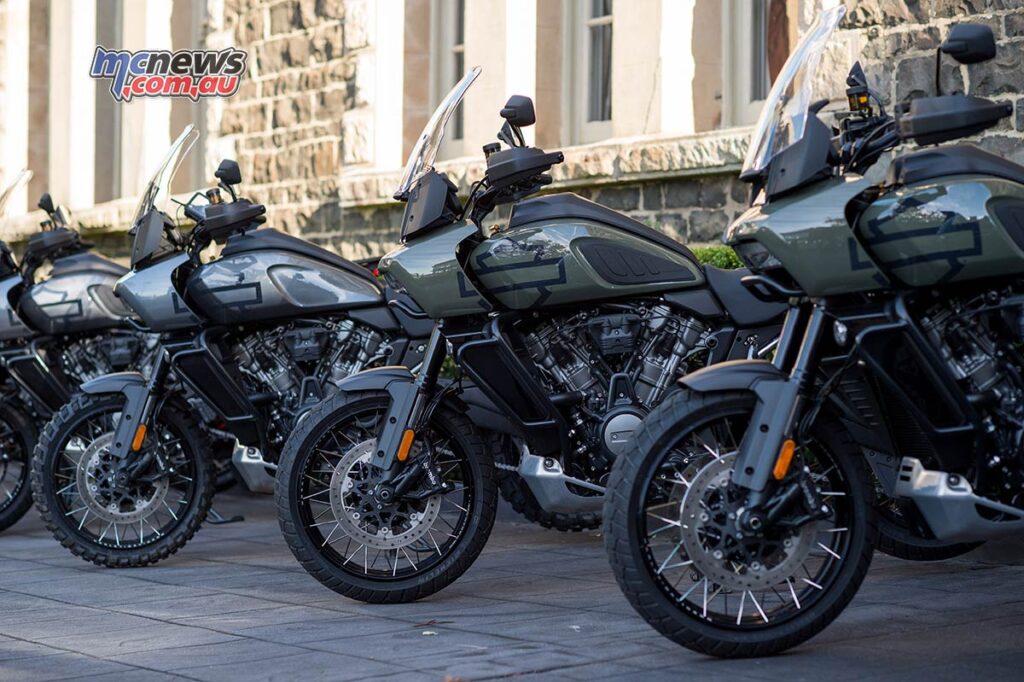
The interesting part of the lowering story is that this effectively reverse-engineers something that Harley had been planning to try and introduce for some time on their cruiser line-up. The original idea was to have a slammed on the deck look, but then be able to raise the ride height when out of the city to provide more suspension travel, and thus comfort. Adventure bikes already have plenty of suspension travel, compliance and comfort, but the trade-off is generally tall seat heights that do little to instil confidence in newcomers, effectively ruling many vertically challenged people out of the large-capacity adventure-touring game altogether. This feature brings those people back into the game, and many are going to be enthusiastic players for Team H-D as a result.
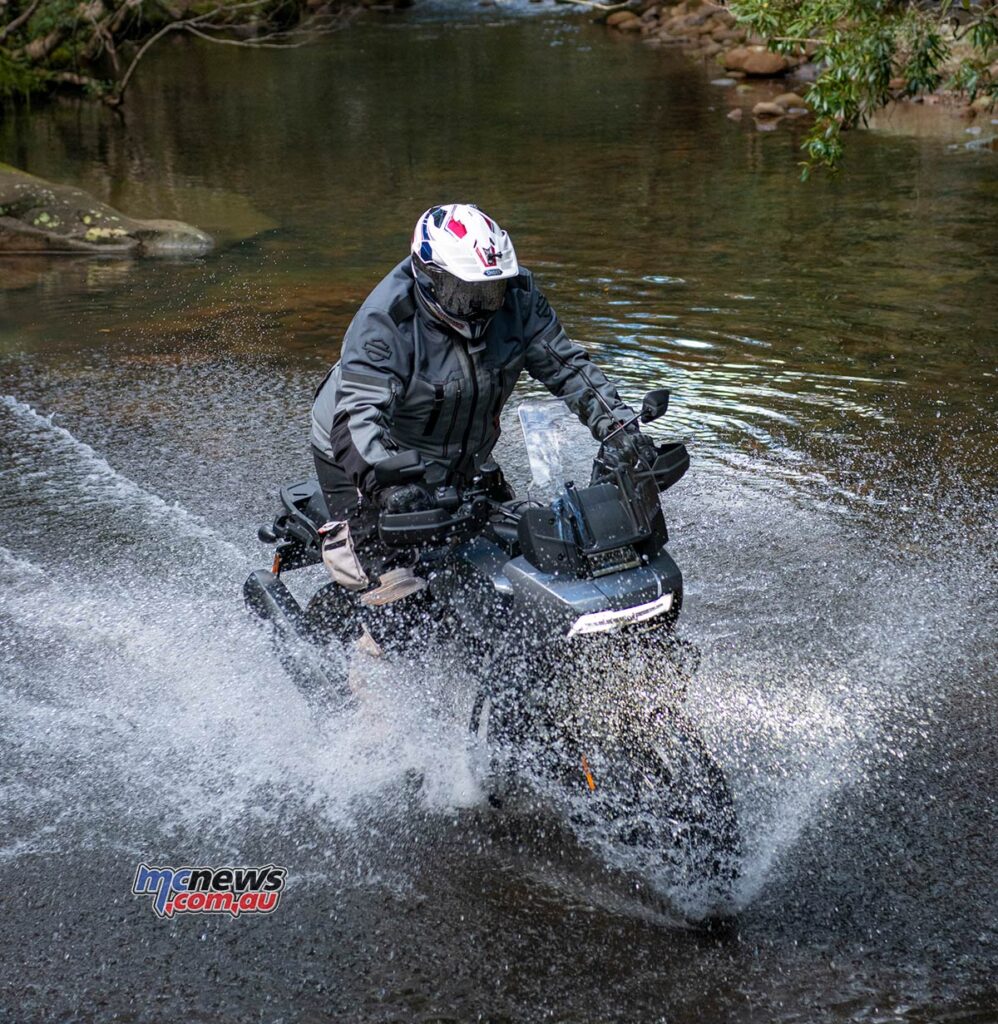
Pan America is not a one trick pony though
It manages to seem a lot smaller than it is and while on the launch we didn’t do any proper serious dirt work, I think it is going to acquit itself quite well in such environs. With 210 mm of ground clearance and 190 mm of suspension travel, it is comparable with most of the 19-inch front opposition.
On unsealed surfaces I was somewhat surprised to find that the Pan America is the least intimidating of all the large adventure-touring motorcycles on the market. No matter how much experience I gain on big jiggers, it always takes some time to regain the confidence required to ride them with any sort of real aggression, especially if I have been out of the seat for a month or two.
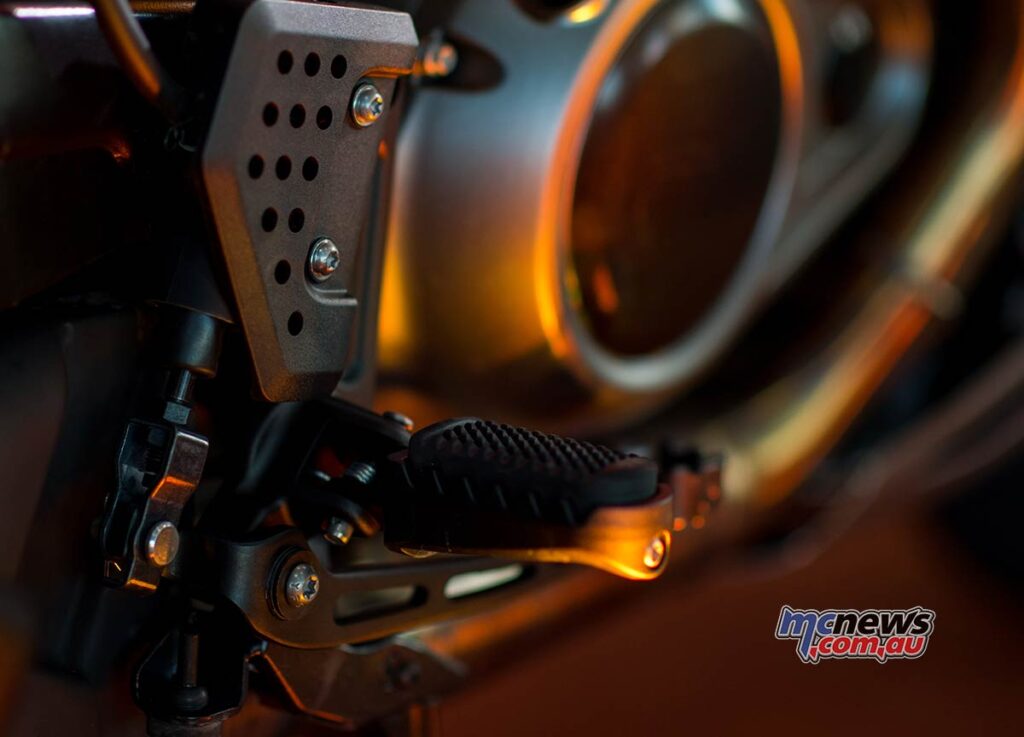
I’ve done plenty of serious sand and clocked up more than 10,000 kilometres on many of the main competitors to the Pan America and, in my opinion, the only bikes that instil more confidence as you first head off-road are those that wear 21-inch front rims. And off-road on a big bike, confidence is somewhat of a necessity. That confidence eventually comes on all the other adventure-tourers, but it comes more quickly on the Pan America due to some sort of Jedi mind trick they’ve managed to pull off that makes the bike shrink around you.
The user-friendly nature of the engine also plays its part. It never ceases to amaze me just how much modern ride-by-wire throttles can smooth out the power deliveries of powerful engines that otherwise might prove more than a little recalcitrant.
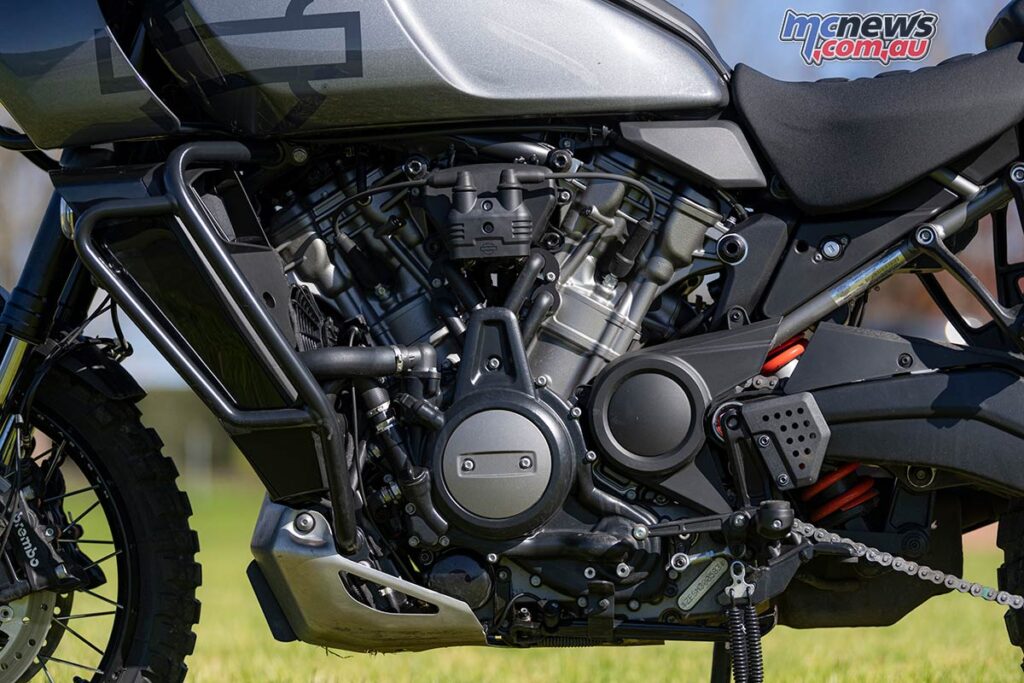
I once owned a KTM 990 Adventure R that was a crazy mofo to ride, it tried to kill me often, but I loved it, and still miss it. Yet the latest KTM Adventure bikes have heaps more power than the 990 era bikes, but are absolute pussycats to ride compared to the 990 era engines. Seriously, don’t let the big numbers scare you, technology has made huge power accessible to the masses.
The 150 horsepower Pan America is the softest pussycat in town though. Pick up from a closed throttle is the smoothest in the business. The way the engine puts the power through to the back tyre makes it feel as though more than a few of those ponies might have gone missing from the paddock.
Twist it a bit harder though and spin that 60-degree v-twin past 6500 and the speed really starts to pile on. Again though, it is still a little deceptive, the electronic speedo is working hard to keep up but you just don’t get that real feel of the urge through the seat of your pants. The acceleration is there and the speed builds strongly, but you just don’t ‘feel’ it as much as you do on most of the competition. The engine is simply so smooth that it hides just how formidable it can be.
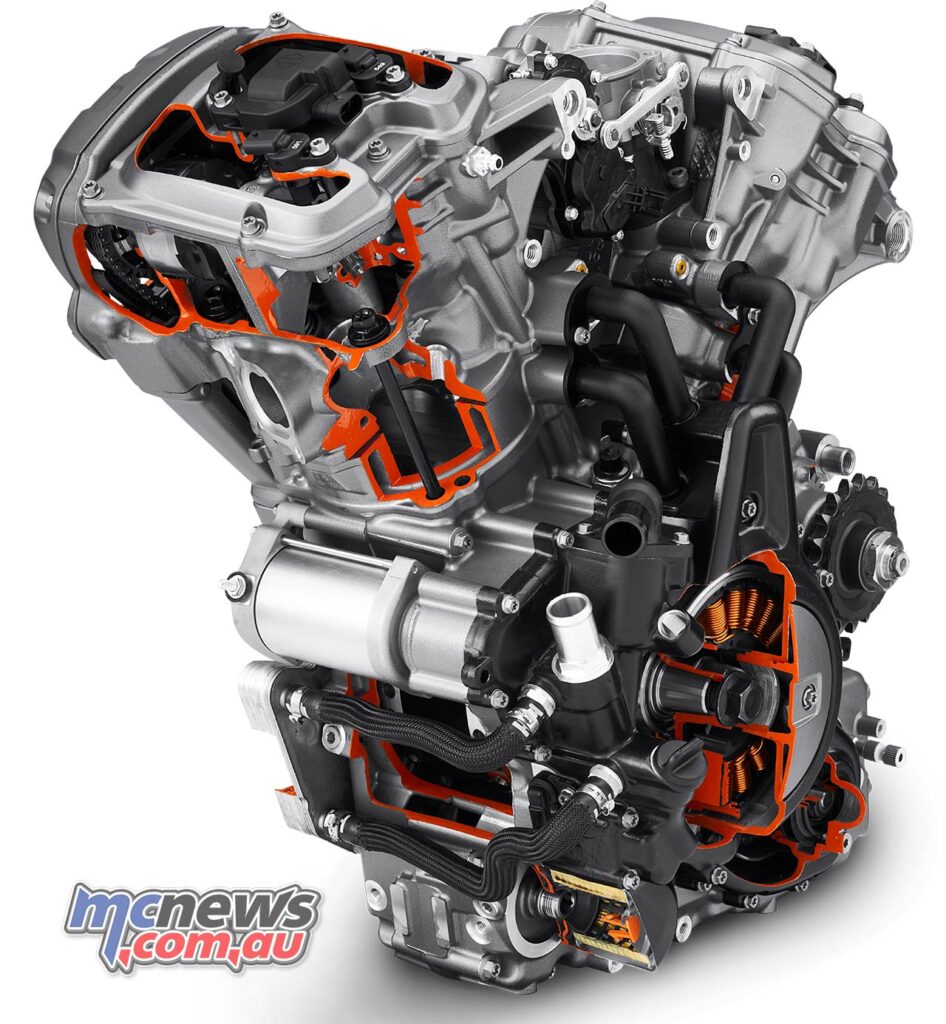
Both the exhaust and intake cams in each cylinder head are advanced in low rpm situations to improve torque, and then that valve timing is pulled back as the rpm increases to deliver the top end horsepower. And this is not a few degrees of change, we are talking a monumental 40-degrees of difference in either direction, that’s massive. It is the most impressive variable valve timing system I have sampled.
Despite all this electrickery taking place between your knees there are no discernible steps in the power delivery, none. But you can definitely feel the engine start to take on a more ferocious new nature as you spin past that 127 Nm at 6750 rpm torque peak and the electronic tacho sweeps towards the 150 horsepower at 8750 rpm crescendo in quickening fashion. The 13:1 compression engine feels as though it wants to keep pulling well past that but the rev-limiter stops play at 9500 rpm. Some of the gears are quite close together which meant I did brush that limiter from time to time as I failed to feed it the next gear quick enough. That really high-lighted the lack of a quick-shifter.
That is a curious omission for a bike so loaded with almost every electronic feature imaginable. It makes me think that Harley have developed one, but some problems with it have delayed the deployment of the feature to the public. There are plenty of ‘not quite right’ quick-shifter set-ups that have destroyed not only gearboxes but also engines. This has become even more critical to get right with the latest generation of two-way quick-shift set-ups. I reckon something like this is why we don’t see a quick-shifter on the Pan America, yet… That, or that the smooth shifting and fairly faultless gearbox does not lend itself to the use of a quick-shifter due to some quirk inherent in the design of the shift drum.
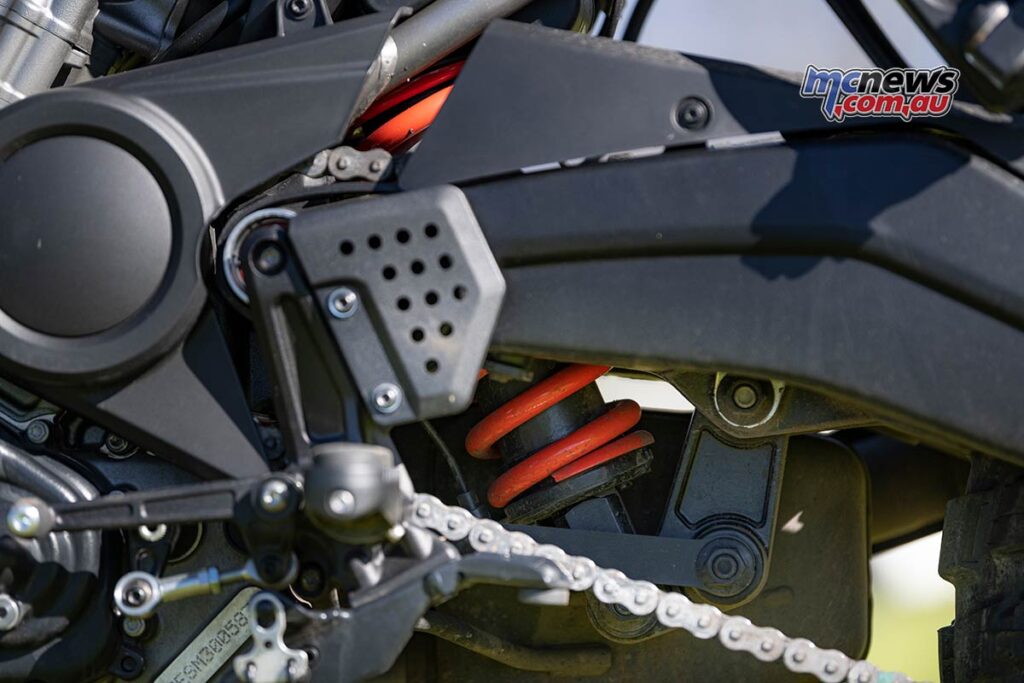
Obviously Harley’s traditional belt drive system was never going to cut it on a bike destined for any serious off-road use. Rocks and grooved belts just don’t go together. Harley have opted for chain drive over a shaft set-up and that is a move I am perfectly happy with. Shaft drives have their benefits for sure, but these days quality chains generally don’t need adjustment outside of service intervals or rear tyre changes. I would expect a 30,000 km chain life, perhaps more due to the smooth running nature of the engine. Modern o-ring or x-ring chains only need a wipe clean if covered in crud and a light spray of lubricant once in a blue moon.
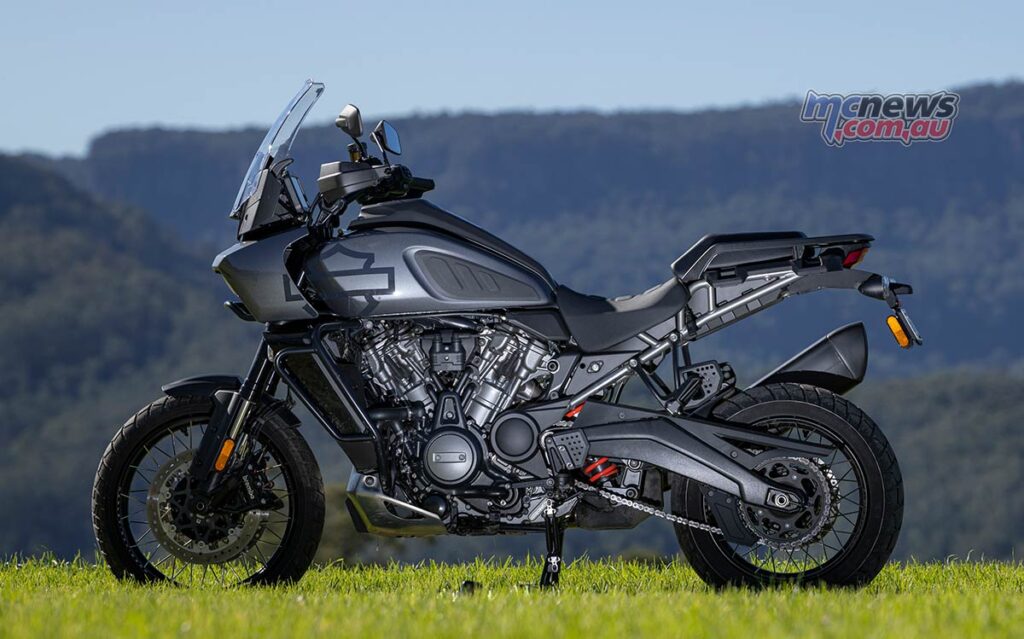
The water-cooled engine has a huge fan that reduces the temperature quite quickly when it gets a little hot under the collar if spending too much time standing still. Coolant also runs through the oil-cooler and there are vanes in the bodywork to direct airflow away from the rider after it has passed through the radiator. It is a dry-sump engine with a three-stage scavenge pump and oil jets under the coated pistons. The crankcase scavenge pump produces enough suction for Harley to employ low-tension rings that reduce friction. Exhaust valves are sodium filled to better resist heat build-up and Harley really do seem to have covered all the bases that should ensure durability.
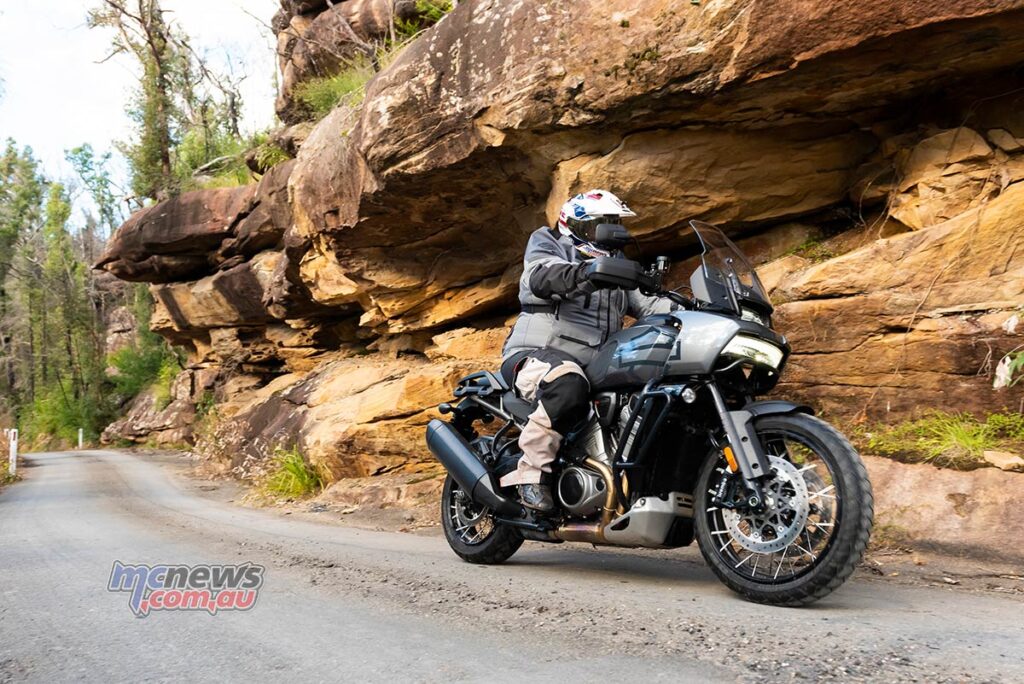
There is no getting away from the fact though that the inside of your legs basically cosset the rear cylinder head. But it is the routing of the rear header that can make your right leg much more uncomfortable than the left. Stop-start city traffic or first gear off-road work in summer I suspect will get uncomfortable mighty quick.
Overall though, who would have imagined that Harley-Davidson would bring to market the world’s smoothest running and user-friendly high horsepower twin? I can confidently tell you they have.
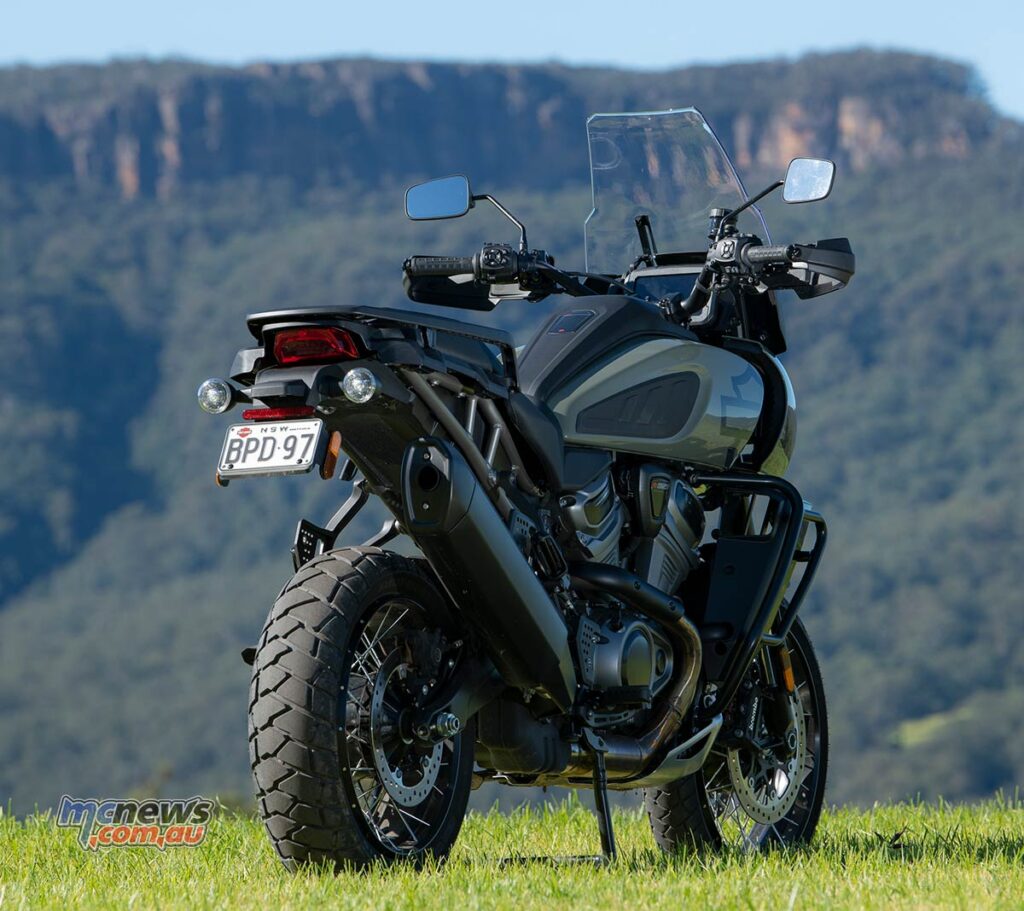
The trade-off is that the engine performs so smoothly that it does leave you feeling that a little of the theatre is missing. While its competitors are European, and feel it, the Revolution Max engine feels so perfectly curated that you could easily mistake it for an engine born from one of the four Japanese powerhouses that have long set the standard for engineering prowess, rather than from the Pilgrim Road Powertrain Operations facility in Wisconsin.
Those long accustomed to my scribblings on motorcycles for the last two decades will know I am not one for hyperbole or embellishment, but this engine is not only a revolution for Harley, it is somewhat of a revolution and revelation in its own right. I admire it greatly and am also a little bit awestruck at what the Americans have produced, but the fact remains that the way it goes about its business still left me a little cold, compared to its European competitors. It’s just missing that discernible wallop in the back of the pants when you hit the throttle, that in-turn produces corresponding action at the front of your pants…. However, I suspect that while the immediate attraction might be missing, the fondness might grow into more love and passion over the long-term rather than a simple one-night-stand.
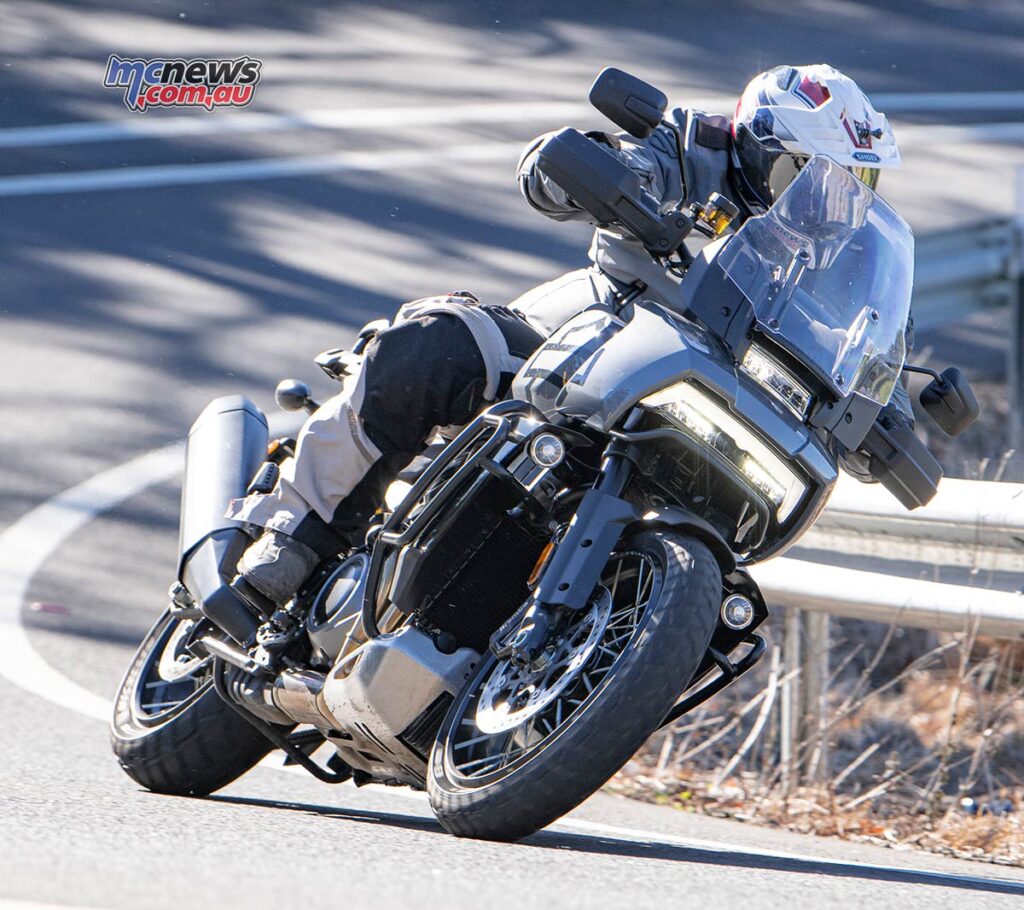
It was, however, love at first sight in relation to the ergonomics. The seat feels narrow when onboard but is still supportive and well cushioned. Granted, I haven’t done any big kilometre days in the saddle, but I suspect there will be no problems on the comfort score and I would happily set out to lap Australia on one tomorrow.
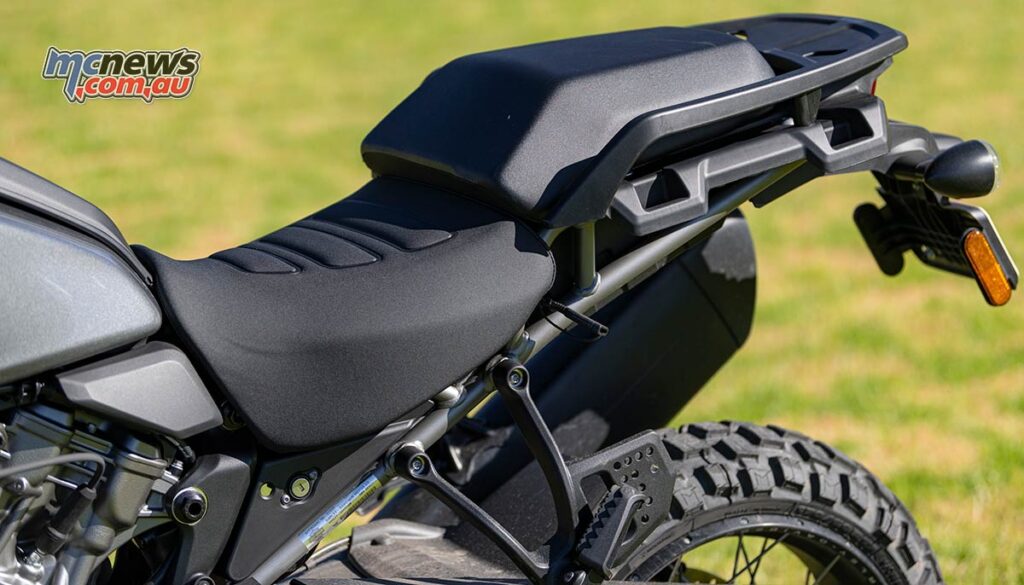
The standard screen is manually adjustable while on the move through four positions and various larger or smaller screens are available as accessories. I don’t reckon I would be changing it. Cruise control works well as do the three-stage heated grips.
Electronic suspension also dramatically helps rider comfort and enjoyment in every scenario. The semi-active suspension system has five modes, ‘Comfort’, ‘Balanced’, ‘Sport’, ‘Off-Road Soft’ and ‘Off-Road Firm’. Thus when you want to play boy racer or sit back and enjoy the ride, the perfect suspension set-up is only the press of a button away.
The different ride modes also change the semi-active suspension, ABS, traction control and engine braking tunes, along with the throttle response and ramp rate to the corresponding scenarios. Harley have also given riders a great amount of freedom to set the machine up with their own set of variables and save them in two extra user modes.
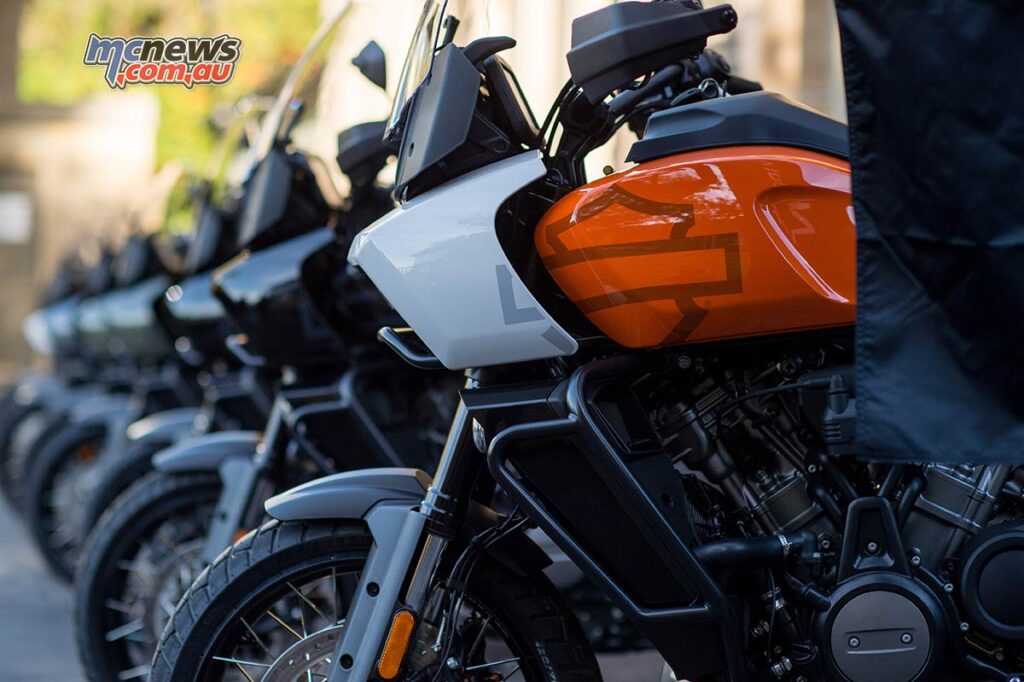
A dedicated ‘Off-Road Plus’ mode deactivates ABS on the rear and places the front ABS in a minimal intervention mode but does not deactivate the system entirely. The ABS system is sophisticated enough that by the time you were in a scenario where complete deactivation would be advantageous, you are probably already in a world of shit anyway. If you have no experience with the latest and greatest ABS systems then you might be throwing your hands up in the air in protest, but for those of us that know how good these systems have now got its no longer a matter of concern. Eventually you just have suck it up and admit that the systems are generally better than you are in any given scenario, particularly an emergency one.
On the road the Pan America steers well, is agile and light underfoot. The launch day saw us on some good roads but mixed conditions and traffic in the places you didn’t want it prevented us from pushing that envelope to see what it could really do. The geometry seems great and the bike shows no hesitation going where its pointed, but we never really got it fully cranked at speed with enough aggression to really judge where it sits in the boy-racer pecking order.
Harley only claim 42-degrees of lean angle via the testing regimen they use to measure such things, but if that figure is calculated the same way the likes of the IMU on the BMW R 1250 GS measures angle of the dangle, then the Pan America will be dragging its undercarriage long before the German starts to feel even a little bit flustered.
I can’t yet judge this area of performance with any real authority before getting the bikes back to back on the same bit of blacktop, that said, I think the Harley will acquit itself quite well. Only those riders that like to lick the stamp and send it into the corners with real aggression will get to appreciate any marginal advantage displayed by the BMW, KTM, Triumph or Ducati in this area. It would be a plain insult to compare the sporting performance of the Pan America to any other model in the current Harley catalogue, it is playing in another contest entirely, and this is the big league full of competitors that have serious sporting potential.
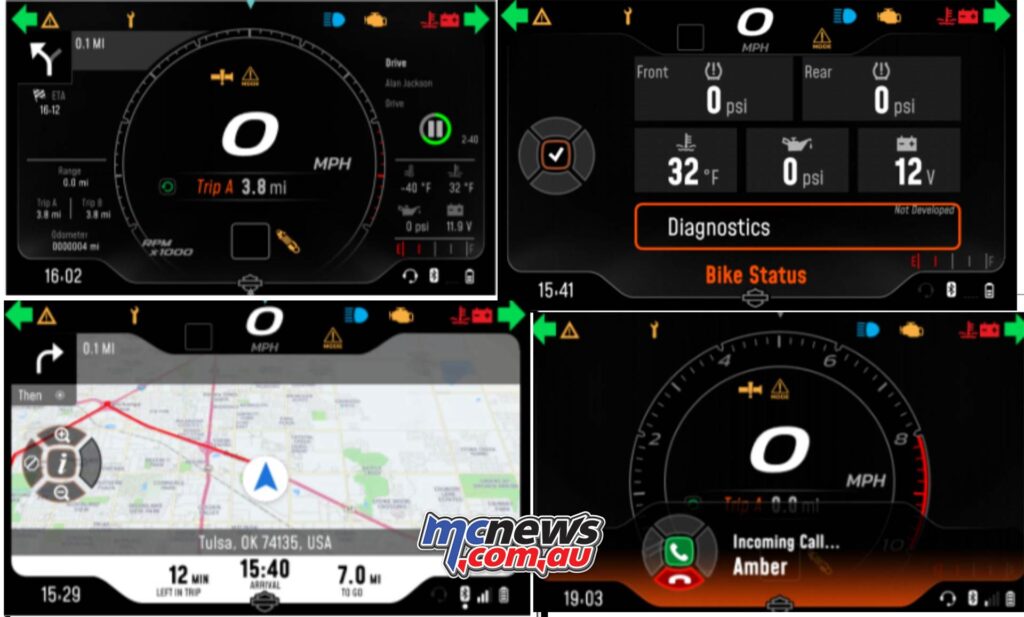
The 6.8-inch TFT instrument panel is done quite well. It has a variety of displays to choose from that can be further customised to suit your tastes. The instrument panel and its surrounding binnacle is adjustable for angle to ensure it caters to riders of various heights. The resolution is good and even small text is legible. It is also a touchscreen but that functionality is only active when stationary.
Images of the instrumentation don’t really do it justice as pictures make it look a bit Fisher-Price, but from the seat it works better and looks better than you might imagine and has all the functionality you could desire. Turn-by-turn navigation is activated via the H-D app on your mobile phone that pairs with the Pan America via Bluetooth. Music works the same way and the whole set-up is very similar to that seen across most motorcycle brands in this day and age. It is executed in a nicer way than most though and only the Apple CarPlay or Android Auto set-up seen on the Africa Twin betters it in any measurable way.
Some of the launch bikes had some minor starting issues that Harley are expecting to have a fix for via a software update before the bikes go on sale. I am sure it will be fixed, but it is worth mentioning all the same.
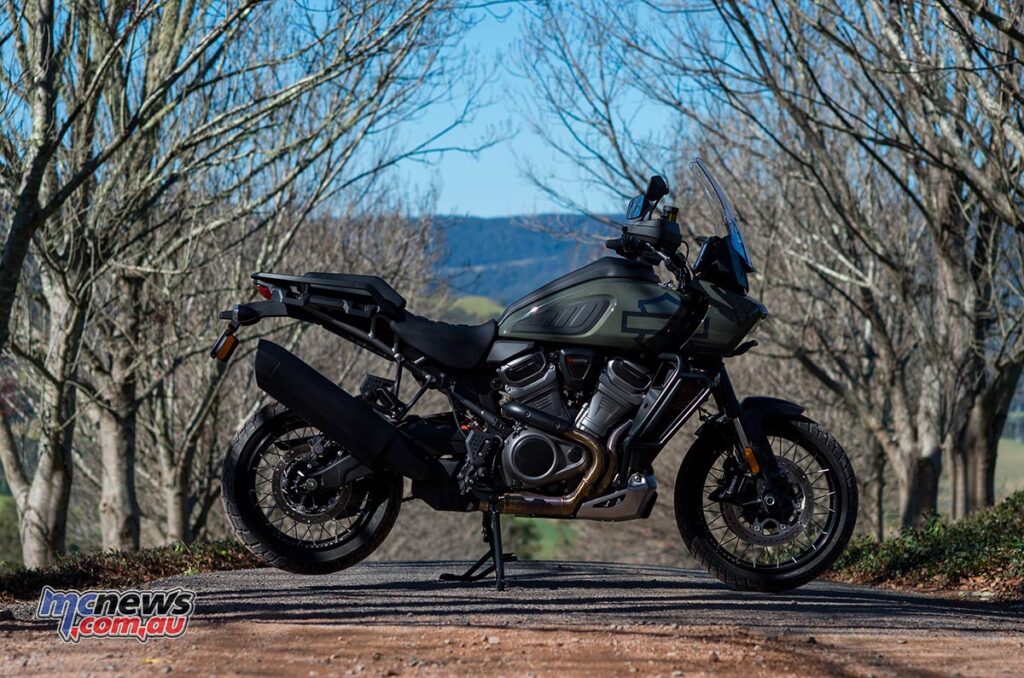
There is a whole lot going on with the switch-gear. There are so many buttons and switches that it seems all a bit too much but, to be fair, they are reasonably well thought out and functional. Still, there are way too many buttons and even though Harley tell us they have done a million miles of durability testing, 50 per cent of which was undertaken off-road, if all those buttons still work after running through a few bull-dust holes over a week in the outback I will be surprised. The competition has spent decades getting this right, and they still experience failures, so I can’t imagine Harley has got it 100 per cent right from day one, time will tell I guess….
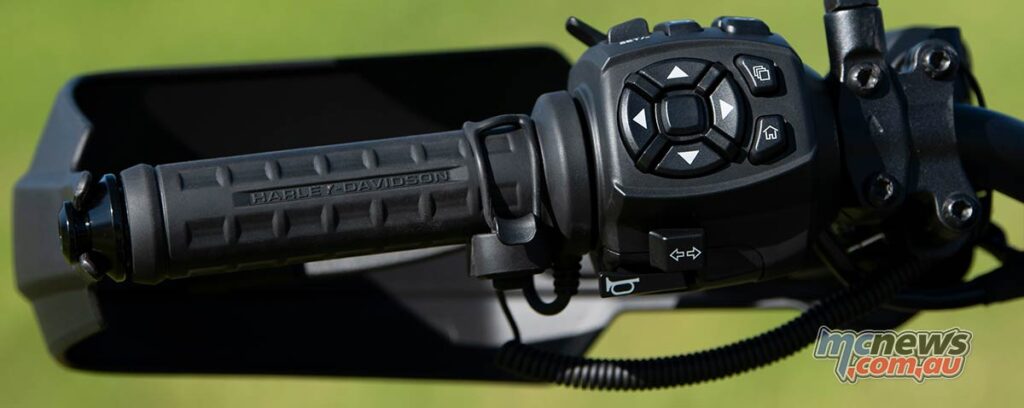
And this perhaps is also the crux of the matter when it comes to Pan America. There is no question Harley have done an absolutely amazing job to write this opening chapter in what they hope will be a whole new profitable book for The Motor Company. But just how right have they got it? Will the early adopters be supported well enough through any teething problems to still be loving Pan America life in 12 or 18 months time?
One would hope that Harley have invested so much in this new platform that they will instruct their dealer network to move heaven and earth to ensure those that choose to put down 32-large on a Pan America feel as though they are part of that new adventure-touring journey with Harley, rather than just being on a Harley…. That will decide how the next Pan America chapter is written, and from there whether it will be a short serial, or a tome of real significance that will leave an indelible mark on the future of motorcycling.
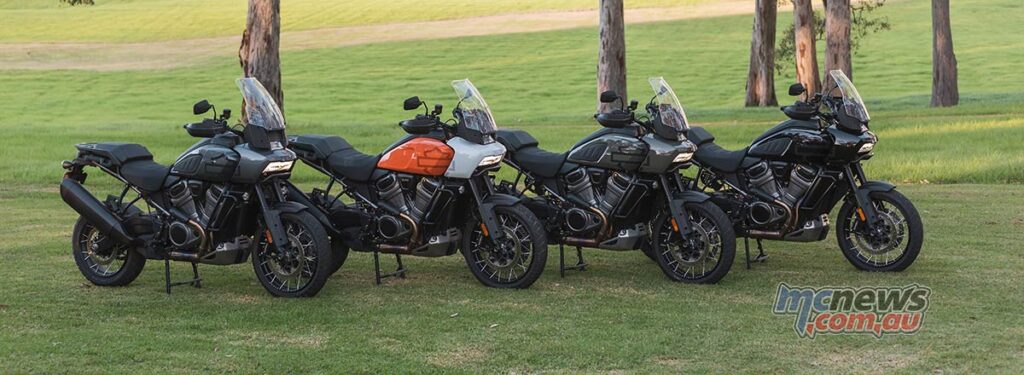
| Harley Davidson Pan America Specifications | |
| Engine | Liquid-cooled, DOHC, 60-Degree V-Twin |
| Displacement | 1,252 cc |
| Bore X Stroke | 105 mm x 72 mm |
| Power | 150 horsepower at 8750 RPM |
| Torque | 127 Nm at 6750 rpm |
| Compression Ratio | 13:01 |
| Fuel System | Electronic Sequential Port Fuel Injection (ESPFI) |
| Exhaust | 2-into-1-into-1; catalyst in header |
| Charging | Three-phase, 45 Amp system (300 Watts @13 Volts, 1200 rpm, 585 Watts max power @ 13 Volts, 2250 rpm) |
| Electric Power Outlet | USB C-Type , Output 5V at 2.4 Amp |
| Drivetrain | Chain Driven |
| Front Fork | 47 mm USD Fork with compression, rebound and preload adjustability. Special model only: Electronically adjustable semi-active damping control. |
| Rear Shock | Linkage-mounted piggyback monoshock with compression, rebound and preload adjustability. Special model only: Automatic electronic preload control and semi-active compression & rebound damping on Special model. |
| Suspension Travel | 190 mm front and rear |
| Rake | 25 degrees |
| Trail | 4.3″ |
| Wheelbase | 1580 mm |
| Ground Clearance | 210 mm |
| L x W x H | 2265 mm x 965 mm x 1510 mm |
| Seat Height | 850 mm (830 in low position or 870 in high position) |
| Front Tyre | 120/70R19 60V Michelin Scorcher Adventure, Radial |
| Rear Tyre | 170/60R17 72V Michelin Scorcher Adventure, Radial |
| Wheels | 19 x 3 in. (F) 17 x 4.5 in. (R) – Cast alloy, spoked rims optional |
| Front Brake | 320 mm twin discs. Radially mounted, monoblock, 4-piston caliper, with cornering ABS |
| Rear Brake | 280 mm disc. Floating single piston caliper, with cornering ABS |
| Display | 6.8 inch viewable area TFT display with speedometer, gear, odometer, fuel level, clock, trip, ambient temp, low temp alert, side stand down alert, TIP over alert, cruise, range and tachometer indication, BT capable – phone pairing to access phone calls, music, navigation (H-D App ONLY) |
| Oil Capacity | 4.5 l |
| Coolant Capacity | 2.2 l |
| Service Interval | 8000 km |
| Fuel Capacity | 21 litres |
| Fuel Economy | 4.9 l/100 km |
| Weight (Fully Fueled) | 254 kg |
| Gross Vehicle Weight Rating | 455 kg |
| Warranty | 24 months (unlimited mileage) |
| Ride Away Price | $31,995 Ride Away – $33,480 with spoked rims and adaptive ride height |
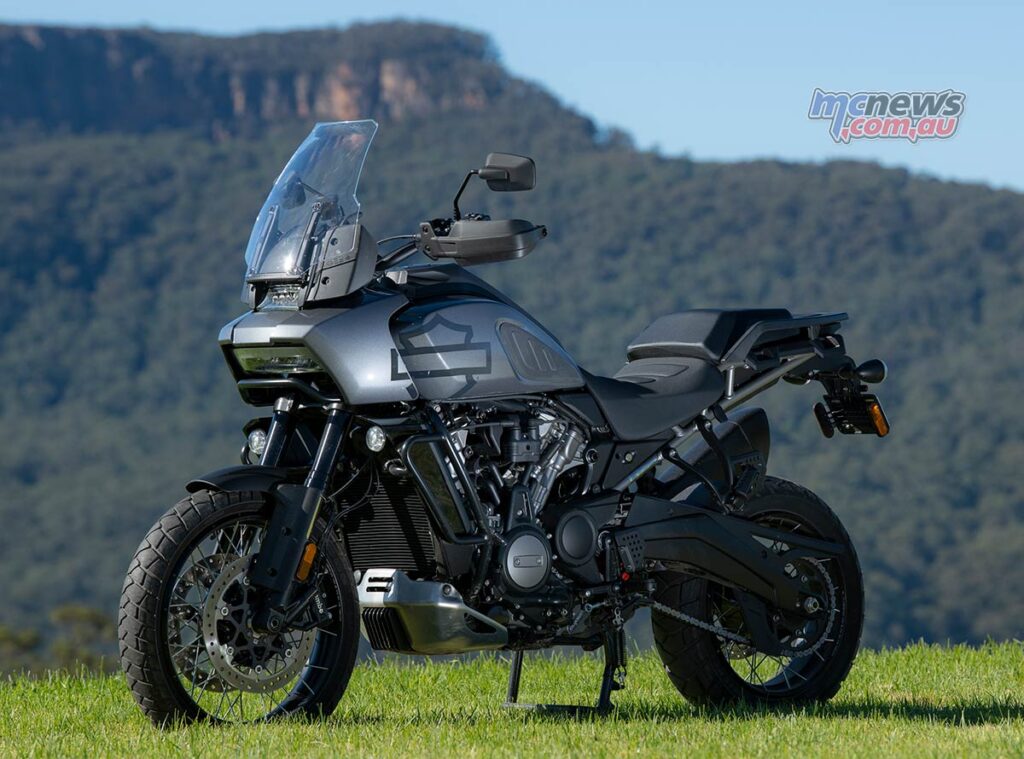
Source: MCNews.com.au
